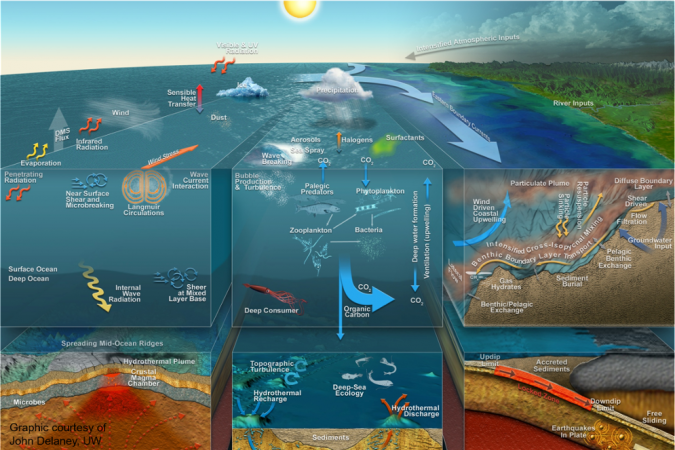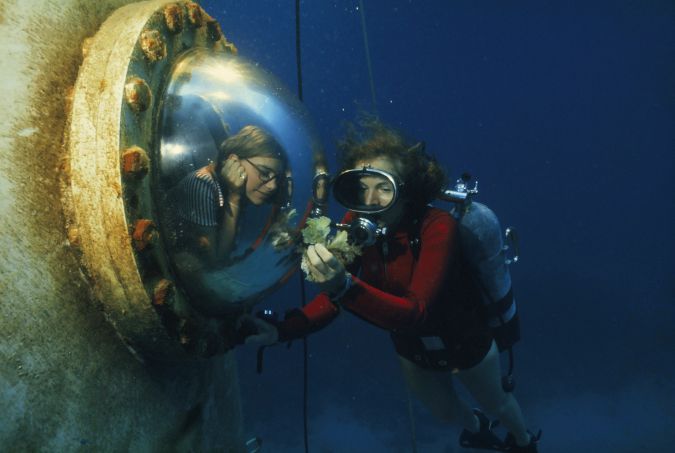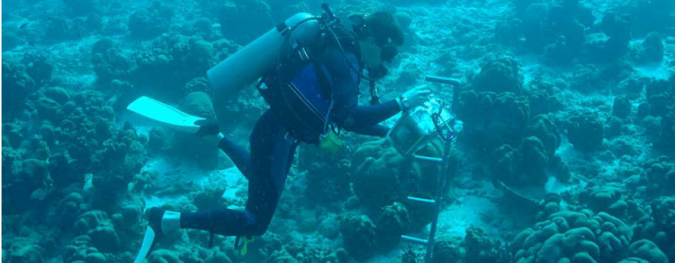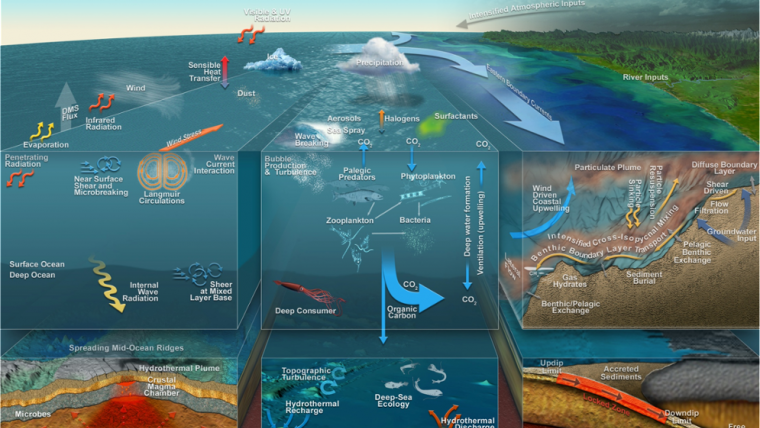Uncovering the Mysteries of the Oceans
What is Oceanography and How to Become an Oceanographer
This article will dig into the field of oceanography and the trends and methods developed over the past decades. Did you know that marine species constitute more than 80% of the Earth’s biodiversity? Or that seaweed and other sea plants living in the ocean produce around 50% of the oxygen in the atmosphere? With this in mind, many efforts are now concentrated on studies of the ocean, such as the identification of conditions beneficial to ocean resources and organisms that can be used as medicines for many critical ailments. In this article, you will also become familiar with terms such as biomimicry, ocean acidification, ocean conveyor belt and paleoclimatology. Stay tuned!
What is Oceanography?
Oceanography, derived from the Greek words ‘Oceanus’ – a Greek water god and ‘graph’ – meaning writing, is a branch of geography that studies the ocean and therefore is also referred to as oceanology. The study of oceanography covers a wide range of topics such as marine life and ecosystems, plate tectonics or the movement of large sections that form the ocean or geology of the seafloor, coastal erosion, movement of ocean currents, formation of waves, and the chemical and physical properties of the ocean. Also within the scope of oceanography are the natural resources found there [1].
Oceanography’s diverse topics of study are generally categorized in four separate but related branches: biological, chemical, geological and physical process of the marine environment.

Biological oceanography, as its title suggests, refers to the organisms which live in the ocean. Researchers in the field (biological oceanographers) study the behaviour of plants and animals (organisms) in the marine environment, their food and breeding habits, and how they affect larger marine creatures. Marine biologists and fisheries scientists are also biological oceanographers. They are interested in the number of marine organisms and how they develop related to one another. Biological oceanographers also focus on how species adapt to environmental changes and how they interact with their surroundings, such as with increased pollution, warming waters and natural or artificial disturbances. A natural disturbance could be a hurricane or the eruption of an underwater volcano, whilst an artificial disturbance could be an oil spill or overfishing [2].
The new technologies developed over the last few years are expanding the opportunities for biological oceanographers. Marine technology, for instance, is the study of how marine resources can be used to develop industrial, medical and ecological products. Many efforts are pointed towards developing new medicines from marine creatures. A process called biomimicry allows researches to understand, isolate and fabricate biological properties from the marine species. Natural compounds for example found in the corals and other marine organisms potentially have an anti-cancer capability, and some proteins consisting in marine algae and bacteria are super absorbent materials used for cleaning oil spills [3]. This makes the application of those studies potentially endless.
Chemical oceanography and marine chemists scrutinize the chemical composition of seawater and its resulting effects on marine organisms, the atmosphere and the seafloor. Their work includes analysis of seawater components and the impact of pollution on marine creatures. They study the unusual and sometimes toxic fluids released by hydrothermal vents in the ocean floor. By mapping chemicals found in the water, they understand how ocean currents move water around the globe, also known as the ocean conveyor belt. Chemical oceanographers also focus on how the ocean affects the climate by studying how the carbon from carbon dioxide (CO2) is buried in the seafloor, highlighting the key role that the ocean plays in regulating greenhouse gases, such as CO2, that is a major contributor to global warming.

Nowadays, ocean acidification is a key topic in chemical oceanography since the ocean is becoming more and more acidic due to increased amounts of CO2 in the atmosphere. More recently, anthropogenic activities have steadily increased the CO2 content in the atmosphere; about 30–40% of the added CO2 is absorbed by the oceans, forming carbonic acid and lowering the pH (previously 8.2, now below 8.1) through ocean acidification [4, 5, 6]. The pH is expected to reach 7.7 by the year 2100 [7]. Chemical oceanographers have discovered that acid disrupts the formation of calcium carbonate, which is the basic building block of shells and corals. [8]
Last but not least, the ocean is rich in minerals and nutrients found in ocean flora. Chemical oceanographers also work to identify the beneficial ocean resources that can be used as medicines.
Geological oceanography studies the structure of the ocean floor, the exploration of the ocean bed and taking cognizance of what changes in the physical structure formed the valleys, mountains and canyons. Geological oceanographers are the scientists who study the past and present compost of the seafloor structure. Through drilling sediment-core samplers and the collection of measurements from under the ocean floor, they look at millions of years of history of physical movements (e.g. volcanic movements that constructed the sea floor). These researches help scientists understand our paleoclimate. Paleoclimatology is the study of weather and climate patterns over millions of years. Greater knowledge of the world’s oceans enables scientists to more accurately predict, for example, long-term weather and climatic changes and leads to more efficient explorations of the Earth’s resources.
Physical oceanography is the branch of oceanography which studies the relationship between the ocean’s physical properties, the atmosphere, the seafloor and coast. Its principal focus is the investigation of ocean temperature, density, waves, currents, tides, the vortex-created eddies, the transport of sand on and off beaches, coastal erosion and the interaction of the atmosphere and the ocean that produces our weather and climate systems. Physical oceanographers investigate deep currents and the transmission of light and sound through water. They predict that global warming will slow the ocean conveyor belt, which will radically change the climate. The melting ice caps will lead to increasing sea levels and hereby the ocean will become less salty and dense.

What does an Oceanographer Do?
An oceanographer works in the field of oceanography and must have a broad understanding of the different topics that reflect multiple disciplines such as chemistry, biology, geology, astronomy, chemistry, climatology, geography, hydrology, meteorology and physics of the water column.
Oceanographers deal with a number of diverse issues including climate changes, declining fisheries, eroding coastlines, the development of new drugs from marine resources, and the invention of new technologies to explore the sea. In fact, ocean scientists and their tools have advanced so much that they can even measure the temperature, depth and salinity of the oceans from space using satellites. Oceanographers have the important task of following the circulation of water, their landward movement and their possibility of generating rain clouds. Together with the meteorologists, they provide information of upcoming cyclones, tornadoes, tsunamis and hurricanes, endangering coastal pollutions. Another important task of an ocean scientist is to closely monitor the changes which occur on the surface of the ocean and in the deeper levels to forecast climatic changes and to mark areas for the availability of natural resources [9].
History of Oceanography
The history of oceanography dates back about 30,000 years when the world’s first seafarers migrated to colonize small islands in the Pacific Ocean. Ancient Greek scientists made observations on tides that were recorded 2000–3000 BC [10]. Around the 14–15th century, the Portuguese Prince “Henry the Navigator” created the first oceanographic school teaching about oceans, currents and mapmaking. In the years that followed, many discoveries were made – both technological and geographical. These ages are named as the “Age of Exploration” in which European navigators and explorers such as James Cook, Ferdinand Magellan, Christopher Columbus and others launched expeditions around the world. Significant information on ocean currents were gathered by different expeditions of the late 18th century, in which important oceanographic devices were launched: the mariner’s compass, the astrolabes and chronometers (allowing sailors to figure out their longitude – a massive advance in maritime navigation).
However, the modern field of oceanography did not drastically change until the late 19th century when America, Britain and Europe joined together to fund expeditions to explore ocean currents, the sea floor and the life that thrive within the ocean [11]. The first organized scientific outgoing to explore the world’s oceans and seafloor was the ‘Challenger Expedition’ (1873–1876). The expedition is claimed to be the beginning of modern oceanography. Challenger travelled nearly 70,000 miles (130,000km) surveying and exploring. On her journey circumnavigating the globe, 492 deep sea soundings, 133 bottom dredges, 151 open water trawls and 263 serial water temperature observations were taken. Around 4,700 new species of marine life were discovered [12].
During World War II, the potential to gain an advantage in submarine warfare spiked a further interest in understanding the oceans. Technologies made at that time, such as the sonar, enabled scientists to measure the sea bottom more accurately than the rope-depth-soundings. The magnetometer, originally developed to discover the metal hulls of the submarines, is used nowadays by oceanographers to depict a better picture of the magnetic properties of the seafloor, and by that, has enhanced our understanding of the Earth’s magnetic core.

Oceanography Today
Modern oceanographers have a variety of tools that help them discover, examine and describe marine environments. Since 1970, satellites have had sensors for measuring and collecting data on wind speed and direction, polar sea ice conditions, sea surface temperatures, and waves. They also provide high-quality images (satellite imagery) of clouds, land and water features.
The satellites send oceanographic and atmospheric data in real-time through a satellite system. This data improves our ability to predict global climate processes or natural phenomena like tornadoes, tsunamis and hurricanes.
Designed to handle more extreme conditions, small autonomous unmanned vehicles (AUV) working as submarines can take samples and high-quality images of the seafloor in depths greater than 5,000–6,000m. They can also collect rock, lava and water samples.
One of the most useful oceanography devices without any hesitation are the oceanographic buoys, mostly moored in the tropical Pacific Ocean. Nowadays, almost all oceanography devices have onboard sensors for detecting water temperature, salinity, oxygen, CO2, chlorophyll and light levels. These physical properties are important for the creation of plankton, which is the main diet of many marine animals.
Conclusion
Despite hundreds of years of research, our knowledge about the oceans is still limited to the top couple of miles of the ocean. There are many species living in the ocean, waiting to be discovered. Seaweed and other sea plants living in the ocean produce around 50% of the oxygen in the atmosphere. Through oceanography, we have learned some amazing facts about the ocean, though there are still many questions to be answered. Since 70% of the Earth is covered by water, much of it remains a mystery. Its immense size and depth will hopefully entice scientists in the future to uncover these mysteries.
References
- National Oceanic and Atmospheric Administration (http://www.noaa.gov), Ocean Facts>> What an Oceanographer does?
- The Editors of Encyclopedia Britannica, Oceanography Science, Britannica.com, Alternative Title: Marine Science, www.britanica.com/science/oceanography3. National Geography, Key Concepts: marine sanctuary, currents, history, biology, chemistry, geography, oceanography.
- EPA, 2013, “Ocean Acidity”.
- Feely, R. A., et. al., 2004, “Impact of Anthropogenic CO2 on the CaCO3 system in the Oceans”
- Zeebe, R. E.; Zachos, J.C.; Caldeira, K; Tyrell, T., 2008, “Oceans: Carbon Emissions and Acidification”.
- Gattuso, Hansson; 2011, “Ocean Acidification”.
- Department of Sustainability, Environment, Water, Population & Communities: Australian Antarctic Division; 2007, “Ocean Acidification”.
- Sonia Madaan, EarthEclipse.com, What is Oceanography and What Does an Oceanographer Do?
- Catherine W., Study.com, What is Oceanography? Definition, History & Facts
- Rice, A. L., 1999, “The Challenger Expedition”. Understanding the oceans: Marine Science in the Wake of HMS Challenger.
- Peter K. Weyl, 1970, Oceanography: an introduction to the marine environment.

Value staying current with hydrography?
Stay on the map with our expertly curated newsletters.
We provide educational insights, industry updates, and inspiring stories from the world of hydrography to help you learn, grow, and navigate your field with confidence. Don't miss out - subscribe today and ensure you're always informed, educated, and inspired by the latest in hydrographic technology and research.
Choose your newsletter(s)
























